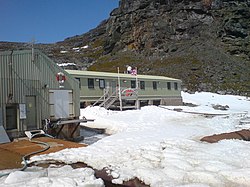Signy Research Station | |
|---|---|
 Signy Research Station in 2006 | |
Location of Signy Research Station in Antarctica | |
| Coordinates: 60°42′30″S45°35′42″W / 60.708333°S 45.595°W | |
| Country | |
| British Overseas Territory | British Antarctic Territory |
| Location in Antarctica | Signy Island |
| Administered by | British Antarctic Survey |
| Established | 18 March 1947 |
| Elevation | 5 m (16 ft) |
| Population (2017) [1] | |
| • Summer | 14 |
| • Winter | 0 |
| UN/LOCODE | AQ SGN |
| Type | Seasonal |
| Period | Summer |
| Status | Operational |
| Activities | List
|
| Website | www.antarctica.ac.uk |
Signy Research Station (originally Station H) [2] is an Antarctic research base on Signy Island, run by the British Antarctic Survey.

